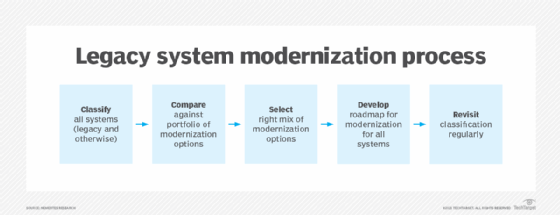
Getty Images
How to modernize legacy applications
For many organizations, system upgrades mean investing time, money and resources. Discover how to modernize legacy applications with these critical tips.
For many organizations, a proactive approach to system modernization is equal parts critical and intimidating.
Tech is integral to enterprise success, which necessitates that all organizations have an IT stack capable of delivering the seamless services and experiences needed to support the company's competitive advantage. That pursuit has CIOs and IT leaders paying close attention to the legacy tech that remains within their IT environment with an eye toward ongoing modernization.
Modernization, however, is a complicated task.
Many legacy systems house large amounts of data and support critical processes. These systems are intertwined with countless other critical systems. Organizations often lack the institutional memory and documentation providing details on their programming and integration points.
Here's a look at six key steps CIOs and IT leaders can use to modernize legacy applications.
1. Get broad executive support
CIOs and IT leaders should not unilaterally undertake modernization work if they want to succeed in the endeavor. Instead, they should seek the support of their C-suite colleagues and the board to gain the resources needed to progress on replacing legacy tech.
"You need the support of executive management so you can get the right people and budgets in place," said Dave Powner, executive director at Mitre's Center for Data-Driven Policy, a nonprofit research and development organization, based in McLean, Va., that provides technical and cybersecurity support to U.S. government agencies.
Cross-departmental support is also important.
CIOs should seek support from the business managers of departments impacted when modernizing legacy apps, said Lisa Highfield, research director at Info-Tech Research Group, an IT services management company, headquartered in London, Ont.
CIOs can earn that support by highlighting the benefits the managers and their teams will see by modernizing, she said.
"You've got to convince them why it needs to be modernized," Highfield said.

2. Consider the organization's market position
Organizations that can quickly react to changing market conditions, employee needs, customer expectations and the broader customer experience will be the most successful.
The organizations best positioned to do all that are those that are the most digitally advanced, said Joe Davey, partner at West Monroe, a digital services firm based in Chicago.
CIOs, along with their executive partners, should assess where they currently stand in their industry and in relationship to their peers and determine where they want to be in the future, Davey said. CIOs should ask whether the executive team wants their organization to be a leader, a laggard or somewhere in between.
"Understand who you are in the industry and where you want to be," Davey said. "That underpins the modernization work to get where you want to be and the gaps you will need to address."
3. Take a strategic approach
The CIOs most successful with their modernization programs are those that take a holistic approach and create a strategy that incorporates business process improvements and identifies new opportunities.
"Make sure that as you assess your applications you take a well-rounded perspective and figure out your strategy," said Suneel Ghei, principal research director at Info-Tech Research Group. "Look at the business value, know where your business wants to be, look at end-user perspectives, look at customers to make sure you're in lockstep with them."
"All those lenses are important when you consider what to modernize," Ghei said.
Such considerations can help determine whether an application can move to the cloud with a lift-and-shift approach. CIOs and IT leaders might find that even with the lift-and-shift approach, it might be necessary to refactor a system to accommodate a new or reengineered business process.
4. Prioritize what's important to the organization
With tech evolving at a rapid pace, many organizations have more legacy tech than can be modernized all at once.
That means CIOs and IT leaders will need to work closely with department leaders not just to get buy-in, but also to understand how different legacy systems are affecting operations, customer experience and employee experience, for example.
This collaboration should identify which systems are holding back the organization, which systems create the greatest risks and which systems are most costly to run. IT can use that information to identify which applications to modernize and in what order -- and pinpoint any systems that can be left alone.
"Just because it's old doesn't mean we have to address it; it might just be fine for now," Powner said.
5. Evaluate for potential risks
Companies transitioning away from older systems might encounter complications from the start. The level of risk involved depends on key factors such as the age and fragility of the outdated tech, whether the organization has skilled employees to carry out the modernization effectively and whether the systems being upgraded are essential to the organization.
For example, replacing a legacy application used by a few workers for a specific back-office task carries less risk than modernizing apps that support core business functions or mission-critical jobs.
"These migrations are risky, so the organization should create a good plan to ensure continuity of operations during the transition," said Nitin Naik, technical fellow at the Mitre Corp.
6. Create an execution plan
As with any project, CIOs and IT leaders should create a detailed plan for each application modernization initiative. The plan should identify needed resources and establish a timeline to complete the work, the required sequence of work, risk mitigation requirements, governance and metrics for determining success.
"You need a plan and a governance board to actually execute," Powner said.
Frameworks can help streamline the process.
CIOs should consider borrowing principles from the Agile software development methodology to break down modernization efforts into smaller chunks of work, Highfield said.
An iterative approach could help CIOs better meet immediate needs while creating more flexibility to respond to future requirements because by being iterative they're not re-creating a monolithic system when modernizing, she said. An iterative approach also helps lower risks and increase chances of success.







